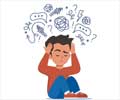By explaining how the brain keeps arousal in check, the new study also provides insight into the neural mechanisms contributing to anxiety or chronic stress, in which arousal appears insufficiently controlled.

‘Human beings perform optimally at an intermediate level of alertness and arousal where they are attending to appropriate stimuli rather than being either anxious or somnolent. ’





Postdoc Vincent Breton-Provencher brought this question to the lab and led the study published Jan. 14 in Nature Neuroscience. In a series of experiments in mice, he shows how connections from around the mammalian brain stimulate two key cell types in a region called the locus coeruleus (LC) to moderate arousal in two different ways. A region particularly involved in exerting one means of this calming influence, the prefrontal cortex, is a center of executive function, which suggests there may indeed be a circuit for the brain to attempt conscious control of arousal. "We know, and a mouse knows, too, that to counter anxiety or excessive arousal one needs a higher level cognitive input," said Sur, the study's senior author.
By explaining more about how the brain keeps arousal in check, Sur said, the study therefore might also provide insight into the neural mechanisms contributing to anxiety or chronic stress, in which arousal appears insufficiently controlled. It might also provide greater mechanistic understanding of why cognitive behavioral therapy can help patients manage anxiety, Sur added.
GABA vs. noradrenaline
Crucial character in the story are neurons that release the neurotransmitter GABA, which has an inhibitory effect on the activity of receiving neurons. Before this study, Breton-Provencher and Sur said, no one had ever studied the location and function of these neurons in the LC, which neurons connect to them, and how they might inhibit arousal. But because Breton-Provencher came to the Sur lab curious about how arousal is managed, he was destined to learn much about LC-GABA neurons.
Advertisement
Advertisement
The next question was which cells in which regions of the brain provide input to these LC cells. Using neural circuit tracing techniques, Breton-Provencher saw that cells in nearly 50 regions connected into the LC cells, and most of them connected to both the LC-NA and the LC-GABA neurons. But there were variations in the extent of overlap that turned out to be crucial.
Two kinds of control
Breton-Provencher continued his work by exposing mice to arousal-inducing beeps of sound, while he watched activity among the cells in the LC. Making detailed measurements of the correlation between neural activity and arousal, he was able to see that the LC is actually home to two different kinds of inhibitory control.
One type came about from those inputs - for instance from sensory processing circuits - that simultaneously connected into LC-GABA and LC-NA neurons. In that case, optogenetically inducing LC-GABA activity would moderate the mouse's pupil dilation response to the loudness of the stimulating beep. The other type came about from inputs -notably including from the prefrontal cortex - that only connected into LC-GABA, but not LC-NA neurons. In that case, LC-GABA activity correlated with an overall reduced amount of arousal, independent of how startling the individual beeps were.
In other words, input into both LC-NA and LC-GABA neurons by simultaneous connections kept arousal in check during a specific stimulus, while input just to LC-GABA neurons maintained a more general level of calm.
In new research, Sur and Breton-Provencher said they are interested in examining the activity of LC-NA cells in other behavioral situations. They are also curious to learn whether early life stress in mouse models affects the development of the LC's arousal control circuitry such that individuals could become at greater risk for chronic stress in adulthood.
Source-Eurekalert













